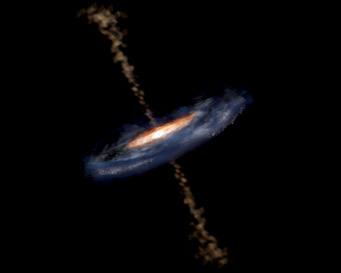As we celebrate the golden anniversary of quasars' discovery, some astronomers are pausing to question the direction of the field.

Kitt Peak National Observatory's 4-meter Mayall Telescope captured an enigmatic view of 3C 273, a strong radio source that appeared star-like at visible wavelengths.
AURA / NOAO / NSF
Fifty years ago on March 16, 1963, astronomer Maarten Schmidt described a peculiar star named 3C 273 in the journal Nature. This star was like none astronomy had ever seen — the strong radio source had an odd set of optical spectral lines, lines that could only be hydrogen Balmer lines, Schmidt wrote, but shifted redward by 16%. In other words, the star had to be speeding away from Earth at 16% of the speed of light. That left two options, both of them extraordinary: either the object was nearby but flying out of our galaxy at ridiculous speeds, or the star wasn’t a star at all, but rather the exceptionally brilliant nucleus of a galaxy 2.4 billion light-years away being carried away by the universe’s expansion.
“At the present time…the explanation in terms of an extragalactic origin seems most direct and least objectionable,” Schmidt wrote then.
And research aligned with his initial thoughts. Within two decades, astronomers from around the world had shown that the massive amount of energy released by faraway quasi-stellar objects, or quasars, likely came from a gaseous disk feeding a supermassive black hole millions or billions of times the mass of our Sun. As the gas spirals into the black hole, it releases energy in the form of radiation and heat, surrounding the black hole with a brilliant glow.

Some feeding supermassive black hole shoot out jets at nearly the speed of light, shown here in this artistic depiction, but astronomers still don't even know what particles make up these jets.
NASA / JPL-Caltech
But despite initial advances, progress has slowed in recent years, Robert Antonucci (UC Santa Barbara) argues in a provocative editorial published in March 14th’s Nature. We still don’t know how black holes produce relativistic jets sometimes speeding millions of light-years into extragalactic space, or even what those jets are made of. We still don’t know what produces the X-rays seen from these sources. And even the gaseous accretion disk supposed to feed black holes has its share of theoretical problems.
“In my opinion, the greatest limiting factor in understanding quasars is not a lack of intelligence, effort or creativity, nor is it a dearth of fantastic new facilities,” Antonucci writes. “It is a wide-spread lack of critical thought among many researchers.”
Antonucci raises a number of criticisms, but chief among them is the lack of theory in the field.
“I see fewer and fewer serious theory papers on AGNs (active galactic nuclei), but there is a burgeoning effort to find ever more quasars in surveys. It is as if, having given up on understanding AGNs, the community now focuses on the more modest goal of counting them.”

This artist's conception illustrates the current picture of what a quasar, or active galactic nucleus, looks like. But many of the specifics of this picture are up for debate.
Aurore Simonnet, Sonoma State University
This exact thought occurred to me more than once during my grad school/postdoc career in the quasar field. But counting AGNs has value too. Most “AGN census” surveys are designed to find those AGNs hidden behind a deep cover of gas and dust, rendering them invisible to most wavelengths. Finding these sources is critical to learning what kind of environment surrounds accreting black holes — especially if there are far more (or far fewer) of these “hidden” AGN than expected.
Antonucci also argues that X-ray astronomy, initially promising, has done little to enlighten the field, in part because of the lack of communication between astronomers studying different wavelengths.
Part of the problem, though Antonucci doesn’t cover this in the editorial, is the different nature of X-ray and optical/ultraviolet observing. Optical and ultraviolet spectra give a wealth of information about the accretion disk that feeds the black hole and the dusty wind that might arise from that disk.
But X-rays are a different story. As a favorite professor of mine used to say, X-ray photons are often so few in number, you can name them. As bright as AGNs are in the X-rays, telescopes such as the Chandra X-ray Observatory have to spend hours, sometimes even days, collecting enough X-ray photons to make a spectrum of lesser quality than a visible-wavelength telescope could collect in minutes. That means all the various processes that produce X-rays, or taken them away via absorption, are crammed into a single, hard-to-understand spectrum. Sometimes I feel it’s a wonder that progress has been made at all.
Some astronomers agree with Antonucci’s call to arms. Bradley Peterson (Ohio State University) adds, “certainly theory is lacking, but so are really meaningful observational constraints.” Other astronomers, who did not wish to be named, have less sympathy for the editorial’s argument. Quasars, as any other object in the universe, will take time to understand.
But regardless of whether the community accepts or rejects Antonucci’s directions for the future of the field, it’s hard to disagree with this: “Without predictive theories we have nothing — our best hope for understanding quasars is that extraterrestrials might drop in and explain them to us.”
 12
12
Comments
Robert L. Oldershaw
March 19, 2013 at 9:23 am
I would think that microquasars, which are stellar scale analogues of galactic scale quasars, might give astrophysicists some major clues about quasars and offer more accessible systems for exploration and testing of ideas.
Another nice example of nature's love of self-similarity.
You must be logged in to post a comment.
Monica Young
March 19, 2013 at 9:46 am
Hi Robert, that's an excellent point that I didn't go into to avoid expounding on this topic ad nauseum, since apparently even here there is controversy. Even though much focus has been placed on microquasars in recent years, Dr. Antonucci suggests this focus is misplaced, at least when it comes to disk physics. He says in the editorial, "The properties of small accretion disks that are inferred to exist around stellar-mass black holes cannot be scaled up to explain the spectra of much more luminous quasars."
You must be logged in to post a comment.
Bruce Mayfield
March 19, 2013 at 11:59 am
To that last quote in your comment Dr. Young, myself and others to I believe are asking, "Why not?" Robert's point about self-similarity across differing scales in nature seems quite valid.
You must be logged in to post a comment.
Anthony Barreiro
March 19, 2013 at 1:17 pm
I'm grateful that I can enjoy skywatching and astronomy as a hobby. I don't have to earn a living or prove my existential worth through discovering new objects or developing a new theory. From my modest perspective, it's remarkable that we've only known of the existence of quasars for fifty years (and very cool to be able to see 3C 273 through a backyard telescope). I can understand the frustration of not understanding how active galactic nuclei work, but let's remember that they're billions of light years distant and completely unlike any physics we can manipulate experimentally! Some things remain mysterious for a long time. As a layperson I imagine that the careful discovery, description, and cataloguing of AGN's will eventually support the development of better theories.
You must be logged in to post a comment.
Monica Young
March 19, 2013 at 1:32 pm
Hi Bruce, nice to hear from you! Yes, Robert's point is certainly valid and probably true to first order, but not everything scales perfectly. Probably the most important difference is that stellar mass black holes cannibalize their companion star, while the food source for a quasar comes from many different sources. So the physics of how material enters the disk will be different, which could affect disk stability, for example.
You must be logged in to post a comment.
Robert L. oldershaw
March 19, 2013 at 1:55 pm
It is also possible that stellar scale Gamma-ray burst sources, and especially short hard GBRs, are even better stellar scale analogues for quasar phenomena.
When you look at the remarkably large and diverse array of astrophysical sources that involve highly energetic back-to-back jets [pulsars, proto-stars, planetary nebulae cores, radio galaxies, quasars, GRB sources, Haro-Herbig sources, SN core objects, BL Lac galaxies, Seyfert galaxies, etc.], then you probably must conclude that there is something common to all of them and something we understand only crudely.
Ultracompact objects at the centers of these systems are probably the common denominator, but our understanding of exactly what is going on needs work, and NEW ideas.
Summarily dismissing discrete cosmological self-similarity is probably not going to be helpful in the long run.
RLO
http://www3.amherst.edu/~rloldershaw
Fractal Cosmology/Discrete Scale Relativity
You must be logged in to post a comment.
Bruce
March 20, 2013 at 7:46 am
Thanks Monica for that answer which does make sense, however differing inputs to ultracompact objects at various scales doesn’t invalidate Robert’s point that there may be fundamentally the same types of physics going on. And I don’t think that in THIS audience of lovers of astronomy your words on X ray astronomy could reach nauseating proportions. Professor Oldershaw, back in January you and Peter had a very interesting debate. Although I agree with Peter’s points he let you have the last word so I guess I have to give you that match as a TKO. I’m starting to read some on your web pages and some of it I find wonderfully insightful while other ideas I find quite unsettling.
You must be logged in to post a comment.
Robert L. Oldershaw
March 20, 2013 at 8:44 am
A shift in cosmological paradigms is going cause considerable anxiety. There is no way around that, and no way to avoid it if the shift is to a better understanding of nature.
I think we are long overdue for such a shift, but the current "standard" paradigms of particle physics and cosmology are deeply entrenched and well-protected from observational threat. They are not theories of principle, but rather they are model-building constructions, which can be "adjusted" arbitrarily. Can't find free "quarks"? No problem - just invent "confinement". So it has gone for many decades.
I forget the previous debate you mention, and I am NOT a professor! Just a mere mortal, thankfully.
You must be logged in to post a comment.
Peter
March 20, 2013 at 9:29 am
I have to agree with Oldershaw on this subject.
You must be logged in to post a comment.
Bruce
March 21, 2013 at 11:52 am
Then there is much agreement here Peter. Roger, I apologize for inferring that you were a professor, and like you, I too am a mere mortal. In point of fact, so too are actual professors, even including Professors of Theology who may actually teach the doctrine of immortality of the soul. (See Ezekiel 18:4, 20) Established paradigms of thought do tend to die hard, don’t they? But in the quest for “a better understanding of nature” a degree of open mindedness is necessary. When one thinks he knows it all he stops learning.
You must be logged in to post a comment.
Peter
March 21, 2013 at 7:28 pm
It's Robert, not Roger.
You must be logged in to post a comment.
Bruce
March 21, 2013 at 10:14 pm
Thanks Peter, and yes an apology is warranted. I'm sorry again Robert.
You must be logged in to post a comment.
You must be logged in to post a comment.